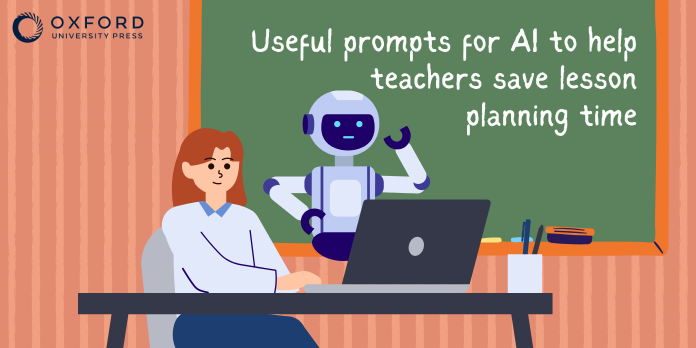In the evolving landscape of education, generative AI stands out as a transformative tool for teachers. AI offers teachers a wealth of opportunities to save time and enhance lesson planning and delivery. By leveraging generative AI, you can not only streamline your teaching workflow but also create more engaging, customised learning experiences for your students. With this in mind, it’s essential we know the right prompts for AI tools so that we get the best and most helpful results possible.
Useful prompts for AI to help teachers save lesson planning time
Generative AI can assist you with your lesson planning. By inputting prompts for AI with specific objectives, desired activities and the target student level, you can receive comprehensive, tailored lesson plans.
Example prompts for AI 1: Generate a lesson plan for B1 level students on the CEFR focusing on past tense irregular verbs. Include the lesson objectives, a warm-up activity, an explanation phase, a written practice task and a role-play speaking exercise. List the necessary materials the teacher and students will need. Give me a list of the steps for the lesson.
(Note: you may need to specify UK vs US spellings and state the duration of your lesson.)
With some AI platforms, you can upload images or documents to complement your prompt.
Example prompts for AI 2: Review my lesson plan below and suggest ways to make it more interactive for my students. Suggest some other resources to add which use free digital learning platforms to revise or practise vocabulary. Also, provide a list of ways to adapt the activities for higher or lower-level students [upload lesson plan].
(Note: you could also prompt the AI tool to differentiate activities for mixed-ability classes, different age levels, neurodivergent learners etc.)
Want to see us test lesson planning with AI tools? Check out our example here.
From worksheets to interactive games, AI can produce a wide range of educational materials tailored to the needs of your English language learners. For example, you could have the AI tool create revision activities for you, or activities for recycling content.
Example prompts for AI 1: Create a worksheet with fill-in-the-blank sentences focusing on present perfect tense for B2 students on the CEFR. Provide sentences, correct answers and explanations in a table with three columns.
(Note: Some online AI tools like ChatGPT will automatically format the text. To remove or add specific formatting, you will need to state this in the prompt, e.g. write the sentences in bullet points with no quotation or speech marks.)
You could also utilise AI to create engaging games tailored to specific grammar or vocabulary topics. AI can also generate role-play scenarios for practical language use, such as interviewer-interviewee interactions which incorporate specific expressions and instructions.
Example prompts for AI 2: Make me a task for B1 level language learners on the CEFR. I want to recycle this language [insert language]. Give me the instructions and task for a roleplay activity for students based on the topic of job applications.
Generative AI can modify texts to match the proficiency level of your students or focus on particular language points. This includes levelling texts up or down, integrating specific vocabulary or grammatical structures and summarising longer texts for easier comprehension.
Example prompts for AI 1: Adjust the following news article to a B1 English level on the CEFR, focusing on simple past and past continuous tenses. Limit the summary to 200 words. [Upload/copy and paste the news article]
You can also change the tone or style of a text to make reading exercises more engaging. For instance, transforming a standard news report into a mystery story can captivate students’ interest while practising reading comprehension.
Example prompts for AI 2: Adapt this news article in a fictional murder mystery story of 600-700 words for English language learners at B2 level on the CEFR. Do not include the crime, only the mystery surrounding the crime. [Upload/copy and paste the article]
Generative AI is a powerful assistant that can inspire creativity, foster engagement and support teachers in the English language classroom. It provides a means to rapidly create and customise teaching materials, adapt content to diverse learning needs and ensure variety in lessons.
However, it’s crucial to remember that AI serves as a complement to and not a replacement for, the teacher’s judgement, expertise and human element in the classroom. When using AI-generated content, you should review it for its accuracy, appropriateness and alignment with learning objectives and language level. Ultimately, you as the teacher know your students more than the AI platform does, so it’s important to use your own knowledge alongside it.
By embracing AI and using these helpful prompts for AI, teachers can enhance their lesson planning, material creation and classroom activities, all while ensuring that their learning objectives are met and students are encouraged and engaged.



Very practícal información. Thanks for sharing.
AI is just repeating the useless stuff that’s been out there for too long a time.
Very useful Thank you so much ??
Very useful Thank you so much ??
What is the AI where you can upload pdf documents or JPG to be transformed to text?